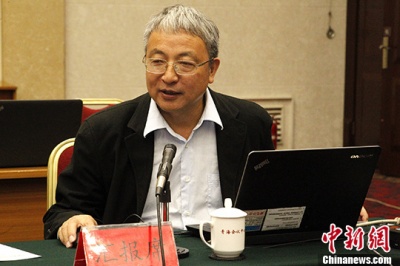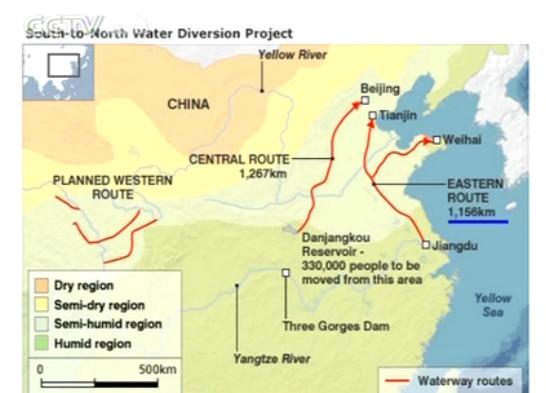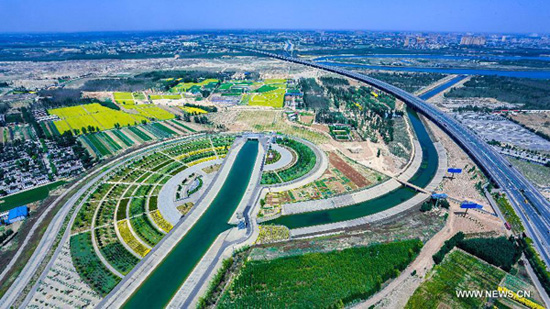

 |
| Wang Guangqian, academician with the Chinese Academy of Sciences and president of Qinghai University, delivers a speech on Sept. 9, 2016. (Chinanews.com/Zhang Tianfu) |
"Once the Tianhe Project is completed, it will be possible to transfer water in the air via an ‘air corridor.' [The corridor] will be formed as part of the South-to-North Water Diversion project," said Wang Guangqian, an academician with the Chinese Academy of Sciences (CAS) and president of Qinghai University. Wang introduced his proposal at a meeting on Sept. 9, which aimed to jumpstart the novel project.
According to the project's description, the atmospheric boundary layer and the troposphere form a passage through which water vapor can be transported in a stable and orderly way. The passage can be regarded as "tianhe" (literally, a river in the sky). The proposed undertaking has therefore been named "Tianhe Project."
"We monitor the content and migration routes of water vapor, and then we conduct interference in certain regions to solve water shortages in northern China," Wang explained.
According to the UN World Water Development Report, northern China will face a severe water shortage by 2025. The established eastern and middle routes of the South-to-North Water Diversion project, which began in 2002, have relieved that "thirst" to some degree. However, the western route is still a work in progress due to high altitude, complex terrain and fragile ecosystems. The air corridor proposition may offer an innovative solution to those challenges.

The South-to-North water diversion project is the biggest project of its kind ever undertaken in China
The South-to-North Water Diversion project is the world's largest water diversion project, according to a Xinhua report. It was designed to transport water from the Yangtze River to dry regions in the north of the country. At its outset, the project was estimated to cost 500 billion yuan ($81.4 billion).
Bao Weimin, a CAS academician and director of the Science and Technology Committee of the China Aerospace Science and Technology Corporation, believes the proposed Tianhe Project and future air corridor are natural next steps toward supporting the ecology of the Tibetan Plateau. Bao also hopes the project will promote national economic and social development, especially in northern China.

File photo taken on May 18, 2015 shows one part of the South-to-North Water Diversion Middle Route Project in Zhengding County, north China's Hebei Province. (Photo/Xinhua)
Tianhe Project will attempt to increase annual precipitation in Sanjiangyuan (the birthplace of the Yangtze, Yellow and Lancang Rivers), the Qilian Mountains and the Qaidam region by 2.5 billion, 200 million and 120 million cubic meters respectively. Its long-term goal is to transfer 5 billion cubic meters of water per year.
 Fire brigade in Shanghai holds group wedding
Fire brigade in Shanghai holds group wedding Tourists enjoy ice sculptures in Datan Town, north China
Tourists enjoy ice sculptures in Datan Town, north China Sunset scenery of Dayan Pagoda in Xi'an
Sunset scenery of Dayan Pagoda in Xi'an Tourists have fun at scenic spot in Nanlong Town, NW China
Tourists have fun at scenic spot in Nanlong Town, NW China Harbin attracts tourists by making best use of ice in winter
Harbin attracts tourists by making best use of ice in winter In pics: FIS Alpine Ski Women's World Cup Slalom
In pics: FIS Alpine Ski Women's World Cup Slalom Black-necked cranes rest at reservoir in Lhunzhub County, Lhasa
Black-necked cranes rest at reservoir in Lhunzhub County, Lhasa China's FAST telescope will be available to foreign scientists in April
China's FAST telescope will be available to foreign scientists in April "She power" plays indispensable role in poverty alleviation
"She power" plays indispensable role in poverty alleviation Top 10 world news events of People's Daily in 2020
Top 10 world news events of People's Daily in 2020 Top 10 China news events of People's Daily in 2020
Top 10 China news events of People's Daily in 2020 Top 10 media buzzwords of 2020
Top 10 media buzzwords of 2020 Year-ender:10 major tourism stories of 2020
Year-ender:10 major tourism stories of 2020 No interference in Venezuelan issues
No interference in Venezuelan issues
 Biz prepares for trade spat
Biz prepares for trade spat
 Broadcasting Continent
Broadcasting Continent Australia wins Chinese CEOs as US loses
Australia wins Chinese CEOs as US loses